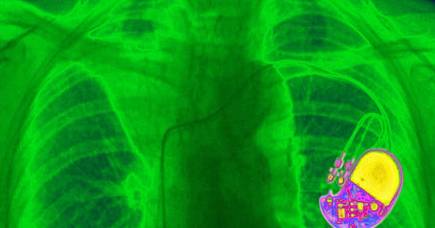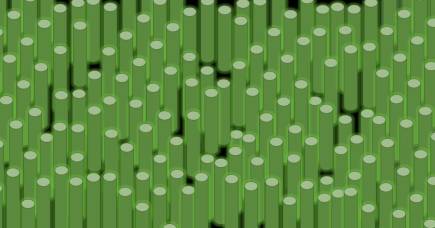Jan 24, 2024
Perché non vuoi l'"energia fantasma" su un veicolo spaziale
Measuring and removing unexpected ‘phantom’ levels of electricity from energy
Misurare e rimuovere livelli “fantasmi” inaspettati di elettricità dai dispositivi di raccolta di energia è stato impegnativo, fino ad ora
Di Ronald T. Leon, Dott. Peter C. Sherrell, Professoressa Amanda V. Ellis, Università di Melbourne
Potresti non aver sentito parlare di materiali piezoelettrici, ma è probabile che ne hai tratto beneficio.
I materiali piezoelettrici sono materiali solidi – come cristalli, ossa o proteine – che producono una corrente elettrica quando vengono sottoposti a stress meccanico.
I materiali che raccolgono energia dall'ambiente circostante (attraverso la luce, il calore e il movimento) stanno trovando la loro strada nelle celle solari, nei dispositivi elettronici indossabili e impiantabili e persino nei veicoli spaziali. Ci permettono di mantenere i dispositivi carichi più a lungo, forse anche per sempre, senza la necessità di collegarli a una fonte di alimentazione.
Ma affinché questi raccoglitori di energia funzionino in modo efficace, dobbiamo sapere esattamente quanta energia possono produrre.
Ora, per la prima volta, utilizzando una semplice tecnica di elaborazione del segnale, il nostro team ha dimostrato che i segnali elettrici utilizzati per valutare i materiali piezoelettrici includono energia elettrostatica (o fantasma).
La nostra ricerca, pubblicata sulla rivista Nano Energy, ha scoperto che viene prodotta più elettricità di quanto ci aspettassimo, in particolare quando raccogliamo energia dal movimento.
Questa energia extra o "fantasma" deve essere presa in considerazione quando si progetta la prossima generazione di elettronica avanzata e, fino a poco tempo fa, non c'era modo di dire quanta energia fantasma (se ce n'era) fosse presente negli accumulatori di energia basati sul movimento. .
Il nostro gruppo di ricerca ha scoperto un modo semplice per identificare se questa energia fantasma è presente, semplicemente osservando il segnale elettrico prodotto da un materiale esposto al movimento.
I materiali piezoelettrici sono utilizzati da diversi decenni per la raccolta e il rilevamento di energia.
La loro applicazione spazia da semplicissimi raccoglitori di energia basati sul contatto a reti complesse di sensori di vibrazioni industriali, pacemaker, dispositivi di monitoraggio della salute strutturale e micro-propulsori nei satelliti spaziali.
I tradizionali raccoglitori di energia basati sul movimento utilizzano uno o più principi di conversione dell'energia, come l'induzione elettromagnetica (ad esempio le turbine eoliche), l'induzione elettrostatica (ad esempio i generatori Van Der Graaff) e la piezoelettricità.
I recenti progressi nella scienza dei materiali hanno accelerato la progettazione e lo sviluppo di materiali funzionali che si basano sul fenomeno della piezoelettricità.
La piezoelettricità converte l'energia meccanica attraverso la deformazione in energia elettrica (tensione). Ad esempio, i polimeri che sono abbastanza flessibili possono subire cambiamenti fisici temporanei, come piegatura o torsione, prima di ritornare alla loro forma precedente.
Ciò, a sua volta, provoca il movimento delle catene polimeriche interne che, in alcuni polimeri, si traduce in una produzione elettrica.
La capacità di questi materiali di produrre continuamente un segnale elettrico con il minimo sforzo ha interessato ricercatori e produttori di molti campi.
Al giorno d’oggi, i materiali piezoelettrici (in particolare i polimeri) sono ampiamente utilizzati come dispositivi indossabili (come scarpe, orologi o guanti intelligenti) per convertire il movimento in energia elettrica che può essere immagazzinata e utilizzata.
Tuttavia, l'attrito che fa sì che il materiale piezoelettrico produca un'uscita elettrica può provocare l'accumulo di cariche elettrostatiche sulla superficie del materiale.
L'elettricità statica è qualcosa che molti di noi hanno sperimentato: ricevere scosse elettriche dopo aver camminato con i calzini sul tappeto o aver guardato i fulmini durante un temporale.
Questo è chiamato effetto "triboelettrico", che può verificarsi quando due materiali qualsiasi entrano in contatto tra loro. Nelle applicazioni pratiche, come la raccolta di energia dal movimento, comprendere questi effetti aggiuntivi introdotti dall’attrito è essenziale per evitare di esporre i complessi dispositivi elettronici a un aumento inaspettato dei rendimenti energetici.
Sfortunatamente, è estremamente difficile distinguere tra segnali piezoelettrici intrinseci e segnali ostacolati dalla triboelettricità. Ciò è dovuto principalmente alle somiglianze tra la piezoelettricità e gli enigmatici segnali triboelettrici.
Dr Peter Sherrell, Professor Amanda Ellis and Ronald T. Leon You may not have heard of piezoelectric materials, but odds are, you have benefitted from them. Piezoelectric materials are solid materials – like crystals, bone or proteins – that produce an electric current when they are placed under mechanical stress. Materials that harvest energy from their surroundings (through light, heat and motion) are finding their way into solar cells, wearable and implantable electronics and even onto spacecraft. They let us keep devices charged for longer, maybe even forever, without the need to connect them to a power supply. But for these energy harvesters to work effectively, we must know exactly how much energy they can produce. Now, for the first time, using a simple signal processing technique, our team has shown that electrical signals used to benchmark piezoelectric materials include electro-static (or phantom) energy. Our research, published in the journal Nano Energy, found that more electricity is produced than we expected – particularly when we harvest energy from motion. This extra or ‘phantom’ energy needs to be factored in when designing the next-generation of advanced electronics and, until recently, there was no way to tell how much phantom energy (if any at all) was present in motion-based energy harvesters. Our research team has discovered a simple way to identify if this phantom energy is present – just by looking at the electrical signal produced by a material exposed to motion. Piezoelectric materials have been used for energy harvesting and sensing for several decades. Their application ranges from very simple, contact-based energy harvesters to complex networks of industrial vibration sensors, pacemakers, structural health monitoring devices and micro-thrusters in space satellites. Conventional, motion-based energy harvesters utilise one or more energy conversion principles, like electromagnetic induction (e.g. wind turbines), electrostatic induction (e.g. Van Der Graaff generators) and piezoelectricity. Recent advancements in materials science have accelerated the design and development of functional materials that rely on the phenomenon of piezoelectricity. Piezoelectricity converts mechanical energy through deformation to electrical energy (voltage). For example, polymers that are quite flexible can undergo temporary physical changes, like bending or twisting, before returning to their former shape. This, in turn, causes the internal polymer chains to move which, in certain polymers, results in an electrical production. The ability of these materials to continuously produce an electrical output with minimal effort has interested researchers and manufacturers from many fields. These days, piezoelectric materials (particularly polymers) are widely used as wearable devices (like smart shoes, watches or gloves) to convert motion into electrical energy that can be stored and used. However, the friction from causing the piezoelectric material to produce an electrical output can result in electrostatic charges accumulating on the material's surface. Static electricity is something many of us have experienced – getting electric shocks after walking in socks on carpet or watching lightning bolts during a thunderstorm. This is called the ‘triboelectric’ effect, which can occur when any two materials contact each other. In practical applications, like harvesting energy from movement, understanding these additional effects introduced by friction is essential to avoid exposing the intricate electronic devices to an unexpected upsurge in energy yields. Unfortunately, it's extremely challenging to distinguish between intrinsic piezoelectric signals and triboelectricity-hindered signals. This is primarily due to the similarities between piezoelectricity and the enigmatic triboelectric signals. So, we shielded energy harvesters, wrapping the equipment in conductive adhesive like carbon tape to identify if the measurements from piezoelectric materials were accurate. We found that signals from shielded energy harvesters (with no triboelectric interference) had a unique frequency response, compared to the signals from unshielded energy harvesters. We found that by simply taking the electrical output from an energy harvester and converting it to the frequency domain, using a common signal processing technique called the fast Fourier transform, it becomes immediately apparent that phantom energy is present in the measurements. This technique can be used by very simple mathematical software like MATLAB. The fast Fourier transform takes an analogue signal, like voltage over time, and converts it to the frequency domain – to see how much and how frequently there is repetition within that same signal. Motion-based energy harvesting is a relatively simple process, so you expect to see a simple frequency spectrum. Think of this spectrum like a single skyscraper. However, when the research team intentionally added phantom energy, this frequency spectrum now looked like an entire city skyline. These so-called harmonic induced distortions can be singled out as phantom energy interferences that, in most cases, amplify the source signal. By knowing how to look for phantom energy, engineers can be confident that any energy harvesting materials, perhaps those in outer space or implanted in the body, will produce the exact amount of energy they need to – no more, no less. The Fourier transform method is regularly used in data analysis to find trends and anomalies within signals and we can use this tool to identify interferences in our piezoelectric measurements. There are many small locations on the energy harvesting devices where friction occurs during testing – and these small locations can make a massive difference to the output. For example, they could take an expected output of 1 volt (V) to 10 V or even 50 V during benchmark testing. While this may seem like a good thing, all this extra energy will not be harvested. The unexpected spike in power is like a fuse blowing during a lightning strike and the device would not be able to cope with the extra energy. Not something you want in outer space or inside your body. We tested piezoelectric samples in a variety of ways and showed, using our simple, fast Fourier transform technique, how phantom energy could be identified during benchmarking. Identifying and measuring phantom energy means researchers can use simple signal filters to isolate and eliminate any interference. Manufacturers of piezoelectric energy harvesters can apply it during construction – confidently creating devices made for bionics, spacecraft or any other precision application – and produce the exact amount of energy they need to improve the lifetime of a device. Maybe forever piezo-lifetimes. This work was completed with the assistance of the Aikenhead Centre for Medical Discovery (ACMD) and the Department of Chemical Engineering, Faculty of Engineering and IT, University of Melbourne, and Andris Šutka, Institute of Materials and Surface Engineering, Faculty of Materials Science and Applied Chemistry, Riga Technical University. Banner: ShutterstockWhy you don't want ‘phantom energy’ on a spacecraft


Harvesting big energy from small movement
Measuring phantom energy


Wearable devices that use human energy


New mobile sensor could transform testing for remote areas
Finding Phantom Energy


Nano inks could change how we use energy
Removing Phantom Energy


The nanowires building greener nanodevices


